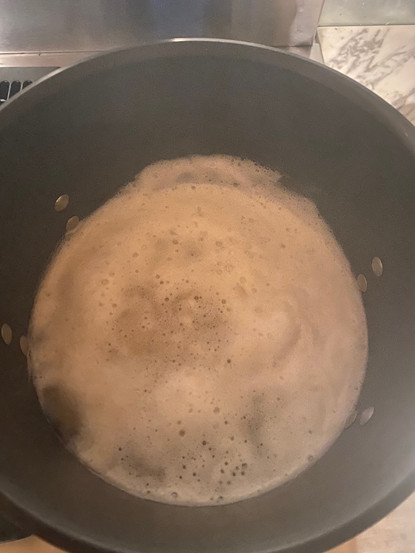The Competition Continues: Hoyt Library, Harriet Ames, My Mother’s Baked Beans, and Hollyhocks
- kellison71
- Aug 27, 2023
- 6 min read
“The Saginaw Evening News declared the Hoyt Library "a noble institution" and "the pride of all Saginawians" when it opened in October 1890. The library was a gift to the people of Saginaw from New York businessman Jesse Hoyt (1815-1882), who had real estate and lumber interests in the Saginaw Valley. Hoyt's will set aside $100,000 for a public library here. After a national competition among leading architects, the Hoyt Trust chose the Boston architectural firm of Van Brunt and Howe. When the Richardsonian Romanesque style building was completed, it exemplified modern library construction. The present building includes a 1921 addition by Edward Tilton of New York and a 1960 addition by Frederick E. Wigen Architects of Saginaw.”
-From the text of the historical marker erected in 2000 by Michigan Historical Center, Michigan Department of State. (Marker Number L2040.)

Although nine hours is a long time to cook beans; it is a short time to attempt the exploration of Hoyt Public Library, Harriet Ames, a hollyhock hedge, and a recipe for baked beans.
Note: If you intend to make Harriet Ames’ recipe for Baked Beans, please move to the recipe portion of this post. Gather the ingredients. As we suspect, you will not have salt pork in your refrigerator and a trip to the grocery store will probably be required. At this point, pick over the beans and start soaking them. Go to bed. When you wake up, prepare the beans. When you have arranged them in a genuine New England bean pot and they are in the oven, it is time to resume your reading. You will have plenty of time.

Harriet H. Ames was the first librarian of Hoyt Library. She was accomplished – brilliant would not be out of line. During her three decades of leadership, she laid the foundations for an institution that continues to serve and enrich the Saginaw community 133 years after opening its doors to the public.
This link will take you to an earlier post about Harriet Ames:
A simple, basic recipe for slowly cooked baked beans – one handed down from her mother – seems to be in perfect character for Harriet Ames. While reading, you may have noted the following lines: “Born in 1834 in Pepperell, Massachusetts, Harriet Ames grew up in an eighteenth-century home about two miles from the center of town. Her father Asa Ames was a cooper – a barrel maker.”
It might be a good time to check your slowly baking bean. You probably won’t need to add additional water at this time. However, at some point you will.
Harriet Ames fully embraced Saginaw. She participated in numerous organizations and public activities. However, her connection to her family in Massachusetts and her passion for the history and heritage of the eastern United States was evident throughout her life in Saginaw. With this in mind, it is not surprising that Harriet Ames would choose to submit a recipe titled “My Mother’s Baked Beans.” A most traditional – one might say almost stereotypical – recipe for publication in the First Congregational Church cookbook.
We found this post helpful in understanding the history of Boston baked beans:
We think you can safely continue reading without checking the beans again. Although, it might not be a bad idea.
Was Harriet Ames’ choice of this recipe simply driven by nostalgia for her childhood? Perhaps - however, we suggest reading this article about the Colonial Revival in the United States.
https://connecticuthistory.org/the-colonial-revival-movement-sought-stability-during-time-of-change/
The Hollyhock Hedge:

When Hoyt Library opened in 1890, the building was much smaller than it is today. The grounds were surrounded by an iron fence. After the government building, the Castle Building, was completed in 1898, the city developed a park between the buildings. It was probably about this time that Harriet Ames had Hollyhocks planted along the fence on the north side of Hoyt Library, which separated the Library grounds from the park. While there is no documentation about who actually planted the hollyhocks, tradition holds that it was always referred to as Harriet – or Miss – Ames’ Hollyhock Hedge.
We don’t know exactly when it was planted. The first documentation is in a 1904 newspaper article, and the following year the library was presented with a photograph of it:
“A Beautiful Gift: Artistic Photographs of the Hoyt Library Presented to the Institution. (To the Editor of The News.)
The main admirers of the fine photograph that has lately been on exhibition at Dansforth’s, will be greatly pleased to learn that Mr. Dansforth has generously presented it to the Hoyt Library. It was taken last July when the hollyhock hedge was in its glory and shows a bit of the lawn and the east the north sides of the library building, giving it quite the appearance of an old English manor house. The skillful hand is evident both in the post of the photograph and its artistic finish, and the giver may rest assured that will be warmly appreciated.
It is a pleasure to record such an example of interest in the library. This year may be happily called ‘the year of blessings.’ A.”
-The Saginaw Evening News, October 12, 1905, p. 2 [Although this letter to the editor is simply signed “A,” we suspect the author was Harriet Ames.]

The hedge would remain in place for many years. Harriet Ames retired in 1918. We believe the hollyhock hedge was removed when the building was expanded in 1921 to accommodate the merger of Hoyt Library with the Public Library.
Depending on how quickly you read, you might want to go check your slowly cooking beans.

Although simply on aesthetic grounds, the planting was beautiful. However, hollyhocks may seem like a peculiar – even odd - choice of flowers for this location. However, considered a traditional planting, they were in perfect harmony with the Colonial Revival Movement – as were the baked beans. The Saginaw paper noted:
“The Old Fashion Sort. On many sides I see evidence that the old-fashioned flowers are coming into fresh flavor. A bright lady writer gives us her experience and observation that there is a decided restoration of the flowers of our grandmothers’ gardens, such as the peonies, poppies, hollyhocks….”
“They were not only most part beautiful in color and form, but a great advantage of their cultivation is that when once planted they will delight the senses for years, if a little attention is only given to them in the spring . . .”
-Saginaw Evening News, July 11, 1881, p. 4.
According to oral tradition, Harriet Ames was protective of the hollyhock hedge and did not allow people to gather seeds.
“Every Saginaw citizen takes a pardonable pride In[sic.] our magnificent Hoyt Library but how many are really aware of the fact that we have one of the best librarians in the country. Strangers have expressed the belief that Miss Ames hasn’t peer in Michigan as a competent librarian. She dropped a remark the other day that is significant of the great educational value of the library when she said: ‘People who come to our library take our books away in their heads instead of their arms.’”
-Saginaw Evening News, January 16, 1904, p. 111.
And there is sound reasoning behind prohibiting the gathering of seeds. Hollyhocks are a biennial. In order to perpetuate a planting, it must be allowed to reseed itself each year.
Normally we would encourage you to visit Hoyt Library and explore the building and collection. However, you have several more hours of bean tending. That is something for another day.
Recipe: My Mother’s Baked Beans

Put 1 qt. pea beans in cold water and soak over night. In the morning pour off the water, cover the beans with fresh cold water, and simmer until soft enough to pierce with a pin. Then turn into a colander, pour cold water through them, and put them in the bean-pot. A genuine New England bean- pot is best, with
narrow mouth and bulging sides.
Take ¼ lb. salt pork, part fat and part lean; pour boiling water over it, scrape the rind until white, cut in quarter inch strips and bury it in the beans. Mix in a cup: 1 teaspoonful salt, 1 teaspoonful mustard, and 2 tablespoonsful molasses. Fill the cup with boiling water, pour the mixture over the beans, and enough water to cover them. Bake 9 hours in a moderate oven. Keep covered with water until the last hour, then raise the pork to the surface just enough to crisp the rind. Yellow-eyed beans and cranberry beans are also excellent when baked.
--Miss H.H. Ames From the Saginaw Cookbook published by the First Congregational Church
Castle Test Kitchen Interpretation

Ingredients:
1 qt pea [navy] beans ¼ lb salt pork
1 teaspoon salt 1 teaspoon dry mustard 2 Tablespoons molasses
Boiling water
Preparation:
Preheat oven to 350 degrees.
Soak beans in cold water for a minimum of 8 hours.
Drain and cover with fresh water. Simmer until soft.
Pour into a colander and drain.
After draining put into bean pot or other suitable baking dish.
Cut salt pork into ¼” strips. (As modern salt pork is prepared differently than it was in the nineteenth century, we deleted the scraping).
Bury salt pork in beans.
Mix in a cup: 1 teaspoonful salt, 1 teaspoonful mustard, and 2 tablespoonsful molasses. Fill the cup with boiling water to make one cup. Pour the mixture over the beans.
Add additional water to cover beans.
Bake 9 hours in a moderate oven. Keep covered with water until the last hour, then raise the pork to the surface just enough to crisp the rind.
Notes: We decided to keep the bean pot covered into the final hour. Which raised the pork to the surface.

Sources:



























